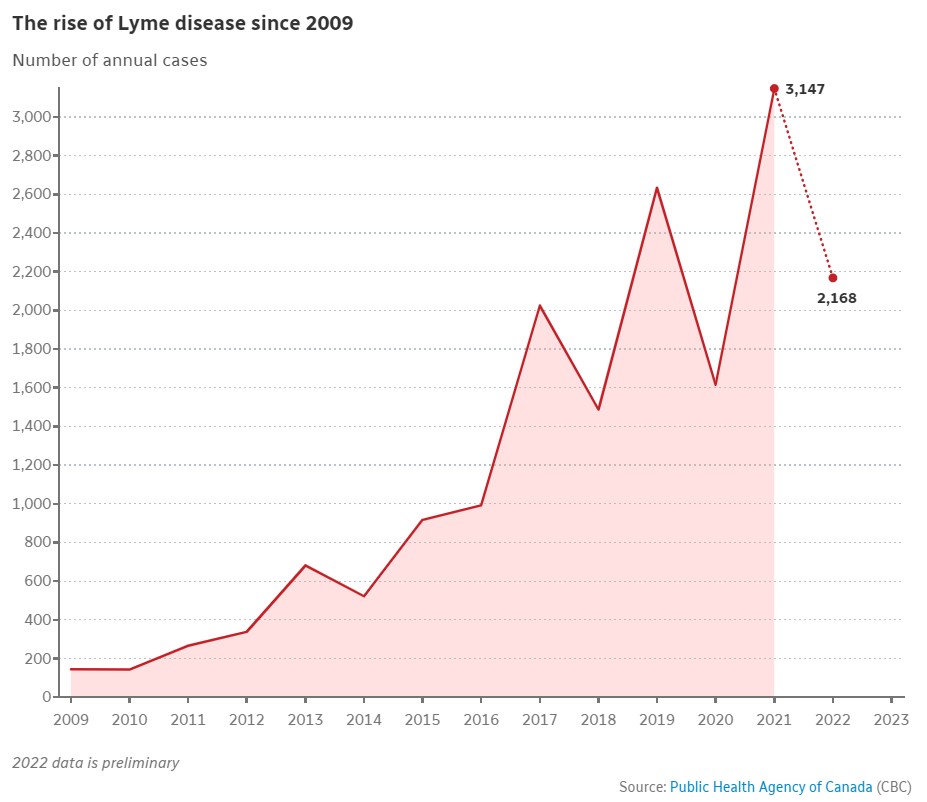Lyme disease, West Nile, and an array of lesser-known infections are on the rise, scientists warn.

This story is part of CBC Health’s Second Opinion, a weekly analysis of health and medical science news emailed to subscribers on Saturday mornings. If you haven’t subscribed yet, you can do that by clicking clicking here.
When Kathryn McKissock’s six-year-old son Cameron didn’t feel like playing in his Oshawa, Ont., backyard this summer, she figured he was just tired. Then he spiked a fever, and started burying his head in his hands. McKissock had a hunch something was seriously wrong.
Cameron ended up being diagnosed with both meningitis and encephalitis, two dangerous forms of brain inflammation, and spent a month in a Toronto hospital. Medical teams didn’t know why her son got sick, until lab reports later revealed a culprit McKissock had never heard of before: Jamestown Canyon, a viral infection carried by mosquitoes.
McKissock was stunned. “They asked us if we traveled, if we had gone anywhere or did anything,” she said. “And we said the only place we have been is our backyard.”
This type of disease doesn’t occur often in Canada, federal data suggests. But scientists warn a slew of insect-transmitted infections are on the rise across North America, fuelled in part by higher temperatures that are helping mosquitos and ticks survive further north, and for longer periods of time.
“We’re seeing shorter winters — winters that aren’t as cold — and basically the expansion of insects that can transmit these infections,” said Dr. Isaac Bogoch, an infectious diseases specialist at the University Health Network in Toronto.
Some are increasingly familiar to Canadians, such as Lyme disease and West Nile virus. But even lesser-known conditions spread by mosquitoes and ticks may be popping up more often, while limited awareness and surveillance means official tallies could be the tip of the iceberg.
“If we start looking for it,” Bogoch said, “we’re going to start finding a lot more of it.”
Infections rising, underreported
Various diseases fall under the umbrella of vector-borne illnesses, meaning any infections transmitted to humans by blood-sucking insects.
In recent decades, scientists began seeing more urban transmission, outside the typical insect ranges, said Dr. Amila Heendeniya, a clinical infectious diseases physician at the Winnipeg Regional Health Authority and an assistant professor at University of Manitoba.
“Something is changing,” he said, “either [through] climate change, the environment, and the urban sprawl — how we’re getting closer and closer to the woods.”
West Nile Disease, a mosquito-borne viral infection which can occasionally cause life-threatening illness, was first identified in Canada two decades ago. Since then, the number of cases has ebbed and flowed, ranging from a handful in a year to more than 2,400 during a particularly nasty season in 2007.
The range of ticks capable of spreading Lyme disease is also growing, alongside more awareness of the treatable, but sometimes debilitating, bacterial infection. That’s pushing reported cases to new heights, federal figures show, with more than 3,000 known infections across Canada in 2021, the most recent year with complete data.
Those tallies could be undercounts, Bogoch said, though more scientists and public health teams are increasingly conducting patient screenings and insect population surveys to close the data gap.

Insect-borne infections on the rise thanks to climate change
Diseases carried by insects that infect humans, like Lyme disease and West Nile virus, are on the rise in Canada. The shorter, less severe winters due to climate change have allowed those insects to expand their range.
Scientists are also bracing for more transmission of other emerging tick-borne threats such as anaplasmosis, a Lyme-like bacterial infection, and Powassan virus — which got its name from the Ontario town where it was first identified in a five-year-old child who died of brain inflammation in 1958.
Ontario just launched public reporting of several additional tick-borne diseases this July — anaplasmosis, Powassan, plus a parasite called babesiosis — and declined to provide early data.
But when CBC News reached out to individual public health units across the province, the total number of possible cases under investigation among those three diseases totalled more than 35. (The data is preliminary, so it’s not clear how many cases will be confirmed. The tallies may also include people who were infected outside Ontario.)
Manitoba, which has been reporting anaplasmosis cases since 2017, typically has a handful of human infections each year, but since these diseases are not yet nationally reportable, the country-wide impact remains unclear.
“We really don’t know what the burden of these infections are in the Canadian population,” said Bogoch. “And that’s because people don’t know these infections are here, physicians and front-line health-care providers aren’t aware of these infections, and they might not be aware of which screening test to use.”
Dr. Dick Zoutman, an infectious diseases specialist with Queen’s University in Kingston, Ont., cautioned against complacency even though the official counts remain small.
“Of course, it starts out that way,” he said. “And then what it’ll look like five years from now, we can only imagine — but we’ve seen how Lyme disease just exploded across Canada.”

Are mild infections flying under the radar?
There’s also a chance ‘rare’ conditions are already less rare than previously thought, since milder cases may be flying under the radar.
Infections linked to California serogroup viruses — which include Jamestown Canyon — were only reported 72 times across Canada in 2018, according to the last-available year of full data.
There are also only an average of 17 serious Jamestown Canyon infections reported in the U.S. on an annual basis, but health officials there stress there is “significant under-diagnosis and under-reporting of less severe cases.”
One Nova Scotia study, published in the journal Emerging Infectious Diseases in 2018, paints a striking picture of the potential burden.

While there’s no official surveillance program to track Jamestown Canyon in that province, researchers who analyzed blood samples of both deer and humans found roughly 88 per cent of the tested deer population had been infected with the virus — alongside more than 20 per cent of the human population. The researchers concluded it may be an “under-recognized cause of disease.”
Given the potential for wider transmission of various emerging pathogens, Canada’s patchwork approach to collecting data is concerning, several scientists stressed.
“Surveillance is foundational, because then you know what’s coming,” Zoutman said. “The more you conduct the surveillance, the more information you get.”
Protect yourself
Dr. Richard Mather, a public health physician at Public Health Ontario (PHO), said Canadians can take a few basic precautions to avoid insect bites in the first place:
- Wear long, light-coloured clothing.
- Wear Health Canada-approved insect repellent.
- Avoid being outdoors for too long at dawn or dusk when mosquitoes are more prevalent.
- Remove standing water that can provide a habitat for mosquito breeding.
Clusters of rare infections in U.S.
South of the border, the situation is even more complex. Even more unusual clusters of rare, insect-transmitted infections have been popping up in the U.S. in the last decade, ranging from chikungunya, best known for causing extreme joint pain, to dengue fever, a viral infection typically found in tropical climates.
“The [mosquitos] capable of carrying it are so widespread in the United States, the potential for an introduction and onward transmission remains a constant threat,” noted Dr. David Hamer, a professor of global health and medicine at the Boston University School of Public Health.
This summer, the country also recorded its first cases of locally-transmitted malaria since the early 2000s, with a cluster of eight cases emerging across Florida and Texas. (Thousands of people each year also catch the potentially-deadly malaria parasite from mosquitos while traveling further south.)
Meanwhile Alabama recently reported several cases and one death linked to eastern equine encephalitis, or EEE. The mosquito-borne viral infection isn’t vaccine-preventable, kills nearly a third of those it infects, and leaves many survivors with ongoing neurological issues.
And in Mexico, rural communities are grappling with one of the most lethal vector-borne infectious diseases on the entire continent: Rocky Mountain spotted fever.
The condition is spread by a type of tick that lives mainly on dogs. More than 2,000 infections and hundreds of deaths have been reported nationwide over the last five years, often featuring symptoms of fever, abdominal pain, and a telltale spotted rash, with children bearing the brunt. The disease remains rare, the Washington Post recently reported, but its incidence is rising.

Links to climate change
A growing body of research underpins theories that climate change is a key factor in the rise of many insect-transmitted conditions.
Scientists suspect higher temperatures are stretching out the season for certain ticks, providing more months of the year suitable for Rocky Mountain spotted fever transmission in Mexico. One 2021 lab-based study even showed a lineage of ticks that live in temperate climates are also twice as likely to bite humans instead of dogs as the temperature rises.
Other research, published earlier this year by scientists in France, showed the tiger mosquito can adapt to transmit chikungunya virus as effectively at 20 C as it does at 28 C as it expands its range to new regions — helping fuel the spread of a condition that can cause debilitating joint pain, which has no approved treatment or vaccine.
It’s a similar situation in Canada, with slight increases in temperatures helping insect populations migrate and thrive further north than before. (The average annual temperature in Canada has already risen 1.9 C from 1948 to 2021, according to Environment and Climate Change Canada, and is projected to increase much more depending on how quickly global emissions are cut.)

New Lyme disease vaccine for humans being developed
A new vaccine for Lyme disease is in the works, and researchers are seeking thousands of volunteers in the U.S. and Europe to test it out.
The geographic footprint that’s suitable for Lyme-transmitting ticks is increasing all the time, and now stretches eastward from Manitoba, public health officials told CBC News earlier this summer. Typically, the climate was cooler, which means ticks have a tougher time finding suitable hosts to feed on, so they eventually starve out — but many are now hitching a ride on birds to far-flung regions of the country that were once inhospitable to either species.
Various research teams have predicted massive growth in tick and mosquito populations in the decades ahead, with one Canadian study suggesting there could also be a West Nile Virus infection rate roughly 18 times higher by 2050 as mosquito ranges expand.
“We’re kind of chasing our tail here,” Heendeniya, in Winnipeg, said, “because we can’t keep up with the climate change.”
Hamer said warming temperatures are just one piece of the complex dynamics at play. Shifting rainfall patterns leading to wetter seasons can provide a breeding ground for mosquitoes, he said, while increased global travel is allowing more diseases to spread between countries at a faster rate.
Urban sprawl into farmland and ongoing human encroachment on animal habitats are also putting more people in contact with insect-carrying wildlife, compounding this simmering public health problem, Heendeniya added.
More awareness needed
As scientists and public health laboratories are racing to monitor these complex conditions, and gauge the spread of multiple emerging diseases, another key question is whether front-line health-care workers are prepared to spot the myriad of insect-transmitted infections, which can sometimes mimic other illnesses, or turn life-threatening.
Clinicians need to be aware of which infectious diseases patients may have been exposed to, in order to ensure a timely diagnosis and treatment, said Mather from PHO.
There aren’t yet approved vaccines to protect people from most insect-transmitted infections — even for major threats like Lyme disease and West Nile — so proper support or medications when patients do fall ill is crucial, several scientists stressed.
For Kathryn McKissock’s six-year-old son Cameron, who is now home with his family after suffering viral mosquito-borne infection, his brain inflammation eventually resolved with supportive care.
But McKissock worries early attempts to treat her son with steroids and other treatments, before medical teams figured out what was wrong, might’ve done more harm than good — and she also wonders now if he’ll have any lasting impacts from his infection.
After her son’s ordeal, McKissock is now using bug spray on her children when they’re playing outside, but she knows it’s not a foolproof approach.
“How do you protect your child from a mosquito?”
ABOUT THE AUTHOR
Lauren Pelley covers health and medical science for CBC News, including the global spread of infectious diseases, Canadian health policy, and pandemic preparedness. Her 2020 investigation into COVID-19 infections among health-care workers won best in-depth series at the RNAO Media Awards. Contact her at: lauren.pelley@cbc.ca
*****
Credit belongs to : www.cbc.ca
 Atin Ito First Filipino Community Newspaper in Ontario
Atin Ito First Filipino Community Newspaper in Ontario






